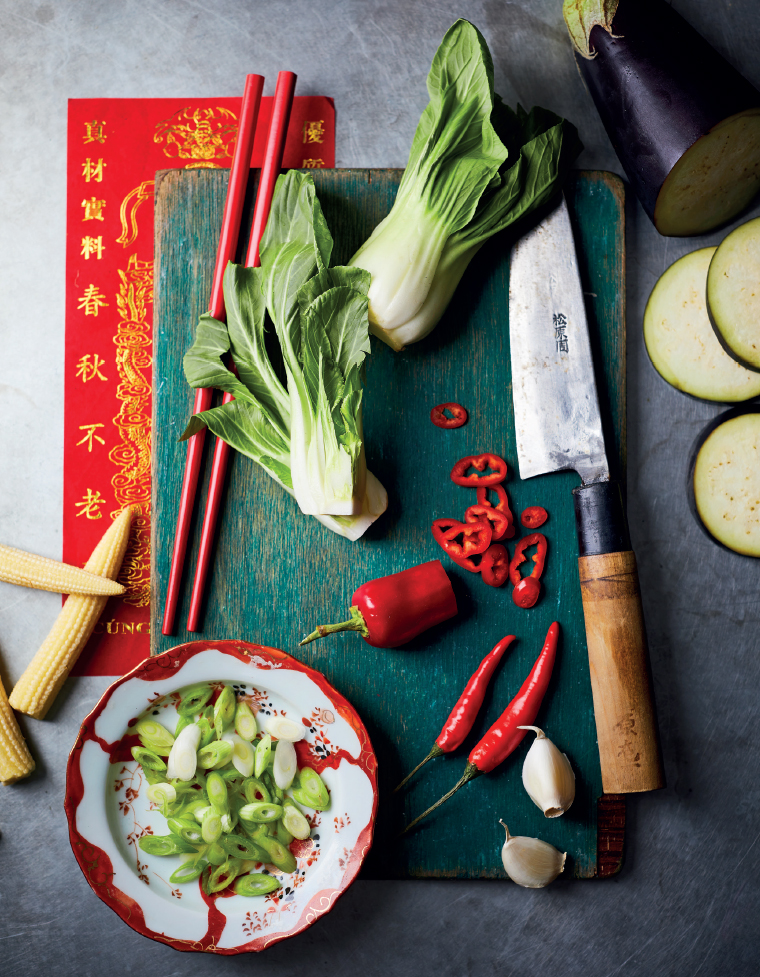 1 tbsp Chinese rice wine (or use water)
1 tbsp Chinese rice wine (or use water)I will admit that many kitchen gadgets can look fancy and fun to use – until you have to wash them, and their many fiddly parts! Aside from the basics in my kitchen – saucepans, sieves, mixing bowls, wooden spoons and roasting trays – five personal equipment essentials are: my folded, Damascus steel chopper, butcher’s block chopping board, seasoned wok, Chinese ladle and bamboo steamers. These serve all my peeling, smashing, chopping, frying, steaming and boiling needs. If you don’t have a wok, a deep-sided frying pan will work just as well and if the thought of a chopper makes you nervous, a sharp kitchen knife will work.
CHINESE COOKING TECHNIQUES
Stir-frying
This is by far the most common method of cooking when using a wok. The wok was designed to sit above an open fire in a clay hole and the thin base and sides are designed to evenly distribute the heat throughout the entire cooking surface. You must remember that once you begin cooking you’ll have to pay full attention to what is going on in the wok as you can easily burn the ingredients if you get distracted. With this in mind it is important that all of your ingredients are prepared before you begin to cook.
Steaming
This traditional Chinese cooking method is considered to be a healthy option as it requires little to no oil. Food is often cooked within a bamboo basket, and the moist heat enhances the food’s natural flavours and locks in nutrients.
Deep-frying
As long as your oil is super-hot this technique of cooking not only locks in the food’s flavour and nutrients, it adds a depth of texture that many other cooking methods cannot achieve. Many believe it’s an unhealthy option but if cooked correctly the hot oil seals the outside of the ingredients, preventing excess oil from being absorbed, and the high heat cooks the food super-fast.
Braising
Slow-cooking in China has been perfected over thousands of years. There are many villages that are famous for their braising methods: cutting the ingredients into small pieces and braising them in small amounts of liquid. Braising makes the toughest of meats tender and juicy, where food literally melts in the mouth and slides off the bone.
Sautéing
This method uses less oil than deep-frying and a lower temperature. Meat is often cut into thin slices and coated in a cornflour batter, cooked on one side and then flipped over to be cooked on the other side. Food becomes crisp on the outside and tender in the middle.
Tenderising
You’ve probably noticed that when you eat at a Chinese restaurant or takeaway, the meat always seems to be supremely tender and juicy and some meats even have a silky smooth texture. The process that can create this texture is called tenderisation; the Chinese call it ‘velveting’. It’s a very simple process, though it does take some planning ahead, as ideally you want the meat tenderising for at least 2 hours before you cook it. Here’s how I would tenderise meat or fish:
 1 tbsp Chinese rice wine (or use water)
1 tbsp Chinese rice wine (or use water)
 1 tbsp cornflour (cornstarch)
1 tbsp cornflour (cornstarch)
 1 tbsp dark soy sauce
1 tbsp dark soy sauce
 1 tbsp light soy sauce
1 tbsp light soy sauce
 1 tsp bicarbonate of soda (baking soda)
1 tsp bicarbonate of soda (baking soda)
Add all the ingredients to a large bowl along with 350–600g (12–21oz) of your sliced meat or fish. Mix everything together vigorously with your hands for 30–45 seconds; there should be no liquid left sitting in the bottom of the bowl. Cover and set aside for, ideally, 2 hours before cooking.
